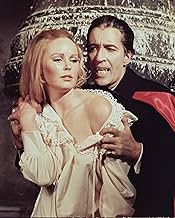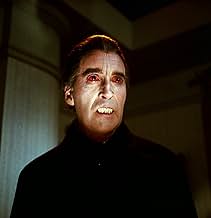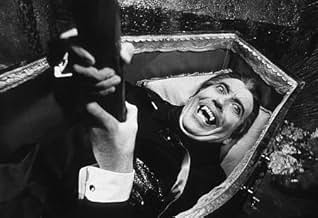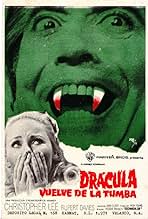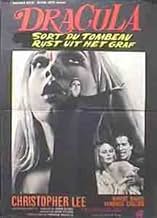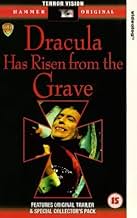AVALIAÇÃO DA IMDb
6,5/10
8,7 mil
SUA AVALIAÇÃO
Quando o Castelo Drácula é exorcizado pelo Monsenhor, ele traz acidentalmente o Conde de volta dos mortos. Drácula segue o Monsenhor de volta à sua cidade natal, aproveitando a bela sobrinha... Ler tudoQuando o Castelo Drácula é exorcizado pelo Monsenhor, ele traz acidentalmente o Conde de volta dos mortos. Drácula segue o Monsenhor de volta à sua cidade natal, aproveitando a bela sobrinha do santo e seus amigos.Quando o Castelo Drácula é exorcizado pelo Monsenhor, ele traz acidentalmente o Conde de volta dos mortos. Drácula segue o Monsenhor de volta à sua cidade natal, aproveitando a bela sobrinha do santo e seus amigos.
- Direção
- Roteiristas
- Artistas
- Prêmios
- 1 indicação no total
Christopher Cunningham
- Farmer
- (as Chris Cunningham)
Carrie Baker
- First victim
- (não creditado)
Donald Campbell
- Tavern Customer
- (não creditado)
Frank Forsyth
- Villager
- (não creditado)
Lindsay Hooper
- Tavern Customer
- (não creditado)
Philip Stewart
- Tavern Customer
- (não creditado)
John Timberlake
- Tavern Customer
- (não creditado)
- Direção
- Roteiristas
- Elenco e equipe completos
- Produção, bilheteria e muito mais no IMDbPro
Avaliações em destaque
A weak script doesn't hinder "Dracula Has Risen from the Grave" from being absorbing most of the way. It has a weak mid-section full of repetitious scenes of Dracula about to take a bite out of a voluptuous female, scenes that don't advance the plot the way they should.
For this reason, some may find fault with the slow pace of much of the film but there's no denying the impressive look of sets, costumes and the proper Gothic atmosphere. Technicolor captures every bit of the shadows and light, just the way effective B&W photography has always done in the past. And the close-ups of Christopher Lee's bloodshot eyes lingers in the mind long after his infrequent appearance has been made.
That's also part of the problem. The role of Dracula really takes a back seat to others in the cast, all of whom are competent performers. Particularly engaging are Veronica Carlson (as one of Dracula's most sought after victims) and Barry Andrews as her infatuated boyfriend. Andrews plays the role of Paul with a saucy cockiness and a twinkle in his eye, easily making what is essentially a cardboard role a standout among the supporting players by virtue of his earnest performance and personality.
Engaging enough as a typical Dracula thriller, but clearly not the best of the Hammer films in this series. James Bernard's music helps keep the suspense level vibrant enough.
For this reason, some may find fault with the slow pace of much of the film but there's no denying the impressive look of sets, costumes and the proper Gothic atmosphere. Technicolor captures every bit of the shadows and light, just the way effective B&W photography has always done in the past. And the close-ups of Christopher Lee's bloodshot eyes lingers in the mind long after his infrequent appearance has been made.
That's also part of the problem. The role of Dracula really takes a back seat to others in the cast, all of whom are competent performers. Particularly engaging are Veronica Carlson (as one of Dracula's most sought after victims) and Barry Andrews as her infatuated boyfriend. Andrews plays the role of Paul with a saucy cockiness and a twinkle in his eye, easily making what is essentially a cardboard role a standout among the supporting players by virtue of his earnest performance and personality.
Engaging enough as a typical Dracula thriller, but clearly not the best of the Hammer films in this series. James Bernard's music helps keep the suspense level vibrant enough.
Early on, "Dracula Has Risen from the Grave" made me feel uneasy... From the scenes of a Monsignor (Rupert Davies) traveling with a priest to perform an exorcism on Castle Dracula in order to bring the superstitious (ha!) congregation back to church on Sunday, to the romantic subplot between a scholarly baker and the Monsignor's daughter, and a distinct lack of Drac, I began to wonder if I was being shortchanged by a title that looked to just capitalize on the success of the Hammer Dracula films. However, the more I kept with it, the more I enjoyed "Grave"--the above-mentioned plot threads, which at first seem corny, are interwoven with delicate skill by director Freddie Francis; the characters and their conflicts are surprisingly endearing (including an angle that brings atheism into the mix); and Christopher Lee is in fine form as the brooding, red-eyed Count (though the production suffers from the absence of frequent co-star Peter Cushing).
The folks at Hammer Film Productions were nothing if not passionate and professional. This entry into the legendary series is only an itty-bitty notch below their inaugural effort, the great "Horror Of Dracula,' as the second best of the entire series.
Chrisopher Lee is at his menacing best. No one can drive a horse-pulled hearse with his fierce intensity. And those eyes, YIKES! What a great effect, one that still gets me 35 years after i first saw the film as a 14-year old in Los Angeles' San Gabriel Valley (and where I saw it on TV not 15 minutes ago).
Hammer vets Freddie Francis and Anthony Hinds create killer-diller fun with strong atmosphere; eerie, colorful lighting and a solid story. And the acting is great, too. Hammer staff composer James Bernard's exciting score adds to the enjoyment.
Hammer's films are for kids ... kids like me who loved then as a teenager and kids like me who are now over 50.
Chrisopher Lee is at his menacing best. No one can drive a horse-pulled hearse with his fierce intensity. And those eyes, YIKES! What a great effect, one that still gets me 35 years after i first saw the film as a 14-year old in Los Angeles' San Gabriel Valley (and where I saw it on TV not 15 minutes ago).
Hammer vets Freddie Francis and Anthony Hinds create killer-diller fun with strong atmosphere; eerie, colorful lighting and a solid story. And the acting is great, too. Hammer staff composer James Bernard's exciting score adds to the enjoyment.
Hammer's films are for kids ... kids like me who loved then as a teenager and kids like me who are now over 50.
If a quintessential example of a Hammer Studio's exercise in Gothic Horror exists, it is probably this film. Not because it is a flawless piece of film-making, far from it. Rather because this film manages to squeeze just about all of Hammer's horror-show templates into it's 92 minute running time.
Here we have the unmistakeably distinctive set design and music score by Hammer mainstays Benard Robinson and James Benard; romantic leads transposing post Summer-of-Love sexual mores (and hairstyles!) to the film's indeterminate post Victorian location; two pub locales, one peopled with wary, hostile, superstitious East-Ender types, the other rollicking with high-spirited youthful inebriates; a pious religious figure (and a much less pious one); a cameo by Michael Ripper; day-for-night location shots; attractive women in low-cut bodices and nightgowns; yet another outlandish method of using trickling blood to revive the antagonist; an eventful screenplay that doesn't measure up to critical evaluation --- whew! I could go on and on.
But please understand, I do not necessarily regard all of the above negatively, just realistically. "D.H.R.F.T.G." is a fun watch if you leave your thinking cap off. Several of the most memorable set-pieces in the Hammer canon are here; the discovery of the girl in the belfry, the attempted staking of Dracula, the Count's seduction of Veronica Carlson, and his over-the-top demise (I won't reveal it here). These scenes lingered for decades in my mind after I saw the film in the early seventies. I was joyful to find the videotape in the '90's and yes, I now happily own the DVD.
One of the harshest critics of this film, incidentally, was it's star. Christopher Lee, who entered the project enduring serious back pain (stuntman Eddie Powell handled the more strenuous action), disliked the script intensely, especially the attempted staking of the Count. His performance, however, betrays none of his vexation; this is one of his best outings as Dracula. Director Freddie Francis coaxes serviceable performances from the rest of the cast. Rupert Davies and Barbara Ewing stand out, as a noble cleric and lusty barmaid respectively.
At the end of the day, I really like this movie, despite it's shortcomings. Heck, I feel like putting on right now. So should you.
Here we have the unmistakeably distinctive set design and music score by Hammer mainstays Benard Robinson and James Benard; romantic leads transposing post Summer-of-Love sexual mores (and hairstyles!) to the film's indeterminate post Victorian location; two pub locales, one peopled with wary, hostile, superstitious East-Ender types, the other rollicking with high-spirited youthful inebriates; a pious religious figure (and a much less pious one); a cameo by Michael Ripper; day-for-night location shots; attractive women in low-cut bodices and nightgowns; yet another outlandish method of using trickling blood to revive the antagonist; an eventful screenplay that doesn't measure up to critical evaluation --- whew! I could go on and on.
But please understand, I do not necessarily regard all of the above negatively, just realistically. "D.H.R.F.T.G." is a fun watch if you leave your thinking cap off. Several of the most memorable set-pieces in the Hammer canon are here; the discovery of the girl in the belfry, the attempted staking of Dracula, the Count's seduction of Veronica Carlson, and his over-the-top demise (I won't reveal it here). These scenes lingered for decades in my mind after I saw the film in the early seventies. I was joyful to find the videotape in the '90's and yes, I now happily own the DVD.
One of the harshest critics of this film, incidentally, was it's star. Christopher Lee, who entered the project enduring serious back pain (stuntman Eddie Powell handled the more strenuous action), disliked the script intensely, especially the attempted staking of the Count. His performance, however, betrays none of his vexation; this is one of his best outings as Dracula. Director Freddie Francis coaxes serviceable performances from the rest of the cast. Rupert Davies and Barbara Ewing stand out, as a noble cleric and lusty barmaid respectively.
At the end of the day, I really like this movie, despite it's shortcomings. Heck, I feel like putting on right now. So should you.
Released in the USA in the Winter of 1969, Hammer's "Dracula has Risen from the Grave" was the fourth entry in the series and the third with Christopher Lee in the title role. Here's a list of the nine films for those interested:
Horror of Dracula (1958); The Brides of Dracula (1960); Dracula: Prince of Darkness (1966); Dracula Has Risen from the Grave (1968); Taste the Blood of Dracula (1969); Scars of Dracula (1970); Dracula AD 1972 (1972); The Satanic Rites of Dracula (1973); and The Legend of the 7 Golden Vampires (1974).
"Dracula has Risen from the Grave" suffers from a weak prologue and first act. The prologue takes place a year prior to the main story. The first act involves two priests hiking up to Dracula's castle to exorcise it. One of the priests unwittingly resurrects the count and the vampire wants revenge on the other priest whom he discovers blessed his abode. The final hour involves Dracula going after his niece in a neighboring village. The niece's boyfriend and the priest must defend her.
Like I said, the whole first act isn't very promising, but things perk up with the introduction of the niece's boyfriend, Paul, and the pub his dad runs. Barbara Ewing plays Zena, the redhead waitress at the pub, and the film shows the close relationships between Paul, his father and Zena. The characters ring true and it draws the viewer into their world. Excellent job on this front.
A great scene takes place when Paul's girlfriend, Maria (played by the stunning Veronica Carlson), takes Paul to her home to introduce him to her mother and the priest, who's a Monsignor (whatever that is). Paul is cornered in a conversation and forced to reveal that he doesn't believe in God. The Monsignor is initially offended and rude, but this can be excused on the grounds that he's the father-figure to his beloved niece; besides there's a warmhearted scene later in the film where the Monsignor proves his loving nature.
Another unusual highlight of the film are the multiple scenes that take place on the labyrinthian rooftops of the Victorian village. I can't help but wonder how they accomplished this. Were they really filming on the rooftops of a village or is it an illusion accomplished through matte paintings or other effects? I'm sure it's the latter; regardless, it's excellent film work and a unique feature of this film.
Of course, Hammer films are renown for their curvaceous women and here we have two: Redhead Barbara Ewing as the very likable Zena, and Veronica Carlson, who can also be seen in the outstanding "Frankenstein Must Be Destroyed".
As with most of Hammer's horror flicks, the movie possesses a beautifully lush, Gothic atmosphere.
Despite the weak first act, the positives noted above compel me place "Dracula has Risen from the Grave" as my second or third favorite of the series. My favorite being "Taste the Blood of Dracula."
The film runs 92 minutes and was shot at Pinewood Studios, Buckinghamshire, England.
GRADE: B
Horror of Dracula (1958); The Brides of Dracula (1960); Dracula: Prince of Darkness (1966); Dracula Has Risen from the Grave (1968); Taste the Blood of Dracula (1969); Scars of Dracula (1970); Dracula AD 1972 (1972); The Satanic Rites of Dracula (1973); and The Legend of the 7 Golden Vampires (1974).
"Dracula has Risen from the Grave" suffers from a weak prologue and first act. The prologue takes place a year prior to the main story. The first act involves two priests hiking up to Dracula's castle to exorcise it. One of the priests unwittingly resurrects the count and the vampire wants revenge on the other priest whom he discovers blessed his abode. The final hour involves Dracula going after his niece in a neighboring village. The niece's boyfriend and the priest must defend her.
Like I said, the whole first act isn't very promising, but things perk up with the introduction of the niece's boyfriend, Paul, and the pub his dad runs. Barbara Ewing plays Zena, the redhead waitress at the pub, and the film shows the close relationships between Paul, his father and Zena. The characters ring true and it draws the viewer into their world. Excellent job on this front.
A great scene takes place when Paul's girlfriend, Maria (played by the stunning Veronica Carlson), takes Paul to her home to introduce him to her mother and the priest, who's a Monsignor (whatever that is). Paul is cornered in a conversation and forced to reveal that he doesn't believe in God. The Monsignor is initially offended and rude, but this can be excused on the grounds that he's the father-figure to his beloved niece; besides there's a warmhearted scene later in the film where the Monsignor proves his loving nature.
Another unusual highlight of the film are the multiple scenes that take place on the labyrinthian rooftops of the Victorian village. I can't help but wonder how they accomplished this. Were they really filming on the rooftops of a village or is it an illusion accomplished through matte paintings or other effects? I'm sure it's the latter; regardless, it's excellent film work and a unique feature of this film.
Of course, Hammer films are renown for their curvaceous women and here we have two: Redhead Barbara Ewing as the very likable Zena, and Veronica Carlson, who can also be seen in the outstanding "Frankenstein Must Be Destroyed".
As with most of Hammer's horror flicks, the movie possesses a beautifully lush, Gothic atmosphere.
Despite the weak first act, the positives noted above compel me place "Dracula has Risen from the Grave" as my second or third favorite of the series. My favorite being "Taste the Blood of Dracula."
The film runs 92 minutes and was shot at Pinewood Studios, Buckinghamshire, England.
GRADE: B
Você sabia?
- CuriosidadesThis was Hammer Films' most profitable movie.
- Erros de gravaçãoWhen the bell-ringer arrives at the church at the beginning of the movie he leaves his bicycle on the steps of the front door. When the priest arrives and rushes to investigate the screaming, the bicycle is no longer there.
- Versões alternativasThe UK cinema version was cut by the BBFC to remove some closeup shots of Dracula pulling a stake from his heart. Later video and DVD releases were uncut.
- ConexõesFeatured in O Sangue de Drácula (1970)
Principais escolhas
Faça login para avaliar e ver a lista de recomendações personalizadas
Detalhes
- Data de lançamento
- País de origem
- Idiomas
- Também conhecido como
- Drácula vuelve de la tumba
- Locações de filme
- Empresa de produção
- Consulte mais créditos da empresa na IMDbPro
- Tempo de duração
- 1 h 32 min(92 min)
- Mixagem de som
- Proporção
- 1.66 : 1(original/negative ratio)
Contribua para esta página
Sugerir uma alteração ou adicionar conteúdo ausente


